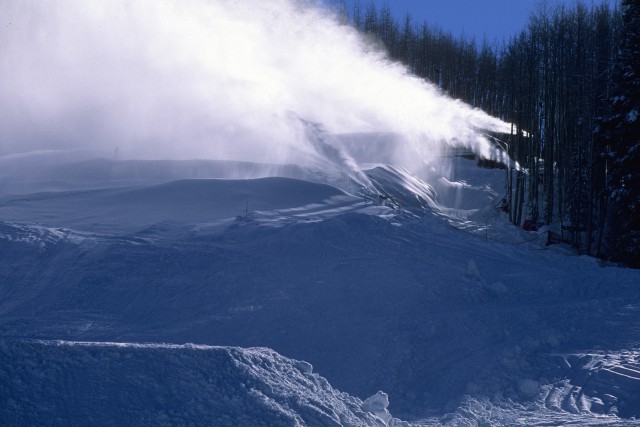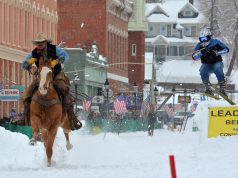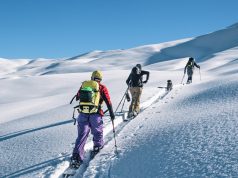
The snow has started to fall. But let’s be honest. To really get the ski and snowboarding season up and running in style, Mother Nature needs a bit of help. A push in the right direction. A jolt of winter.
Some snow. And any kind of snow will do.
Enter snowmaking. Without it, many Colorado ski areas would face a fickle opening date. With it, some consistency is created.
It’s true that aficionados of skiing and snowboarding look down upon man-made snow. It’s also true that they have a point: Mother Nature still does a better job, and there’s nothing quite like two feet of Mom’s finest coating your favorite mountain. But snowmaking allows resorts to open sooner, when there may be plenty of powder on the upper slopes but the lower mountain is snow-challenged. Man-made snow also allows for other things, like Breckenridge’s massive terrain park or Copper Mountain’s halfpipe at the bottom of the mountain. And man-made snow also lays down the kind of hard, fast and slippery surface essential for Beaver Creek’s Birds Of Prey World Cup races, where athletes expect and need a firm, icy surface not only for speed (these guys clock in at just over 80 mph in the downhill races) but also for safety. The harder snow surface withstands racers’ edges better, and maintains a consistency not found with natural snow.
While most of us won’t be bombing down any World Cup race courses in the near future, the fact remains that snowmaking benefits us. Among other things, it allows us to start our season earlier.
“Our average opening day is the 15th of October,” says Loveland Ski Area’s John Sellers. “The cold temperatures and our location help, but snowmaking is essential to getting things going in October.”
According to Sellers, Loveland utilizes two types of snowmaking devices, fan guns and nozzle guns. Fan guns look a lot like what the name suggests. They’re oversized tubes, like a massive Coke can cut in half. Inside the tube, water and air are combined, and a fan pushes the resulting mixture into the air, which crystallizes and falls on the slopes as snow. Nozzle guns look like something left over from a sci-fi flick, with a long nozzle combining pressured air and water to make the snow.
“These guns are better in marginal conditions,” Sellers says of Loveland’s nozzle guns. “On warmer nights, we can still make snow.”
The key, says Sellers, is a magical combination of low temperatures combined with low humidity.
“The colder and dryer it is, the more productive we can be,” he says, noting that Loveland’s high base elevation of 10,800 feet also helps. “We start at the top, where it’s higher and colder, and work our way down.”
As usual, Loveland went up against Arapahoe Basin to be the first central Rocky Mountain resort to open, a race that is, according to Sellers, “good natured and fun.” Both ski areas, however, were trumped by Southern Colorado ski area Wolf Creek, which pulled off something of a coup when the mountain opened on Oct. 8 with a 36-inch base of natural snow.
While Loveland lost the race this year — A-Basin opened Oct. 13 — for Vail, getting open is more of a planned event. Scheduled to open on Nov. 18, the resort relies on snowmaking to ensure that the lifts start running as scheduled. Still, even with snowmaking, conditions can vary wildly, from one run and one lift available on opening day to last year’s insane powder fest, which illustrates what happens when Mother Nature decides to cooperate.
“Oh yeah, I’d love to have another opening day like last year,” laughs Paul Fillon, senior director of mountain operations for Vail. “Mother Nature really helped us out.”
According to Fillon, rather than making snow as soon as temperatures allow (which is right now), the resort has a schedule and sticks to it. That means commencing snowmaking on Nov. 1, with an eye towards getting limited terrain open by the resort’s scheduled opening day, regardless of what happens with the weather.
“We make snow with an eye towards production,” says Fillon. “Making snow is expensive, you have to pump water up the mountain, there are all these costs that go into the process.”
That reason, according to Fillon, means that although today’s high-tech snowmaking guns can make powder, they’ll more likely be laying down a base that stands up to grooming and skier traffic than trying to reproduce the best that nature has to offer.
“Because of the costs, with any system you want to optimize production,” says Fillon, who says that Vail relies on a variety of types of guns to ensure that the mountain opens on schedule. “We have fan guns, tower guns, about five different types, including energy-efficient guns.”
“It’s a bit art and a bit science,” adds Fillon. “With most guns, there’s pressurized water and air being pumped through the system, and the snowmaker is making adjustments at the gun.”
While this system works, it’s up to the snowmaker to judge the right mix for the current humidity and temperature, variables that can change hour to hour and even minute to minute.
“Automated technology takes the variables out of it,” says Fillon. “There are new systems that are completely automated, and they are very good at what they do.”
Still, despite this technology, it’s a good idea, according to Fillon, to pray for a bit of help from Mother Nature if you’re a skier or snowboarder.
“We can get pretty close with our technology,” says Fillon of the manmade snow that you’ll find at Vail.
“But we’ll never be able to match Mother Nature.”
Respond: [email protected]














